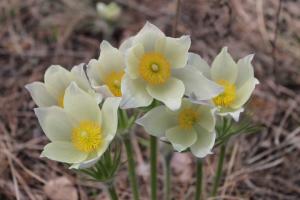Globular chrysanthemums were bred quite recently for growing in gardens, and in a short time they managed to gain great popularity. These flowers are exceptionally decorative and at the same time unpretentious in care. The flower feels great in open ground and does not cause much trouble with planting.
Varieties and varieties
IN Lately spherical chrysanthemums are incredibly popular. And the number of varieties reaches four thousand hybrids of various colors, including blue and green shades. Only viewing numerous photos will help you decide on the choice of variety. Low chrysanthemum bushes are densely dotted with flowers, which gives them a special charm. These plants bloom from August until frost.

The bushes of this chrysanthemum have the shape of a ball, densely strewn with flowers.
Here are some of the common varieties:
- "Ida" - a bush up to 60 cm tall in the shape of a ball, dotted with small (up to 3 cm in diameter) flowers. Blooms from September.
- "Knopa" - different abundant flowering. During flowering, the low bush (30-35 cm) is completely covered with yellow flowers, the number of which reaches 160 flowers at a time.
- "Multiflora" is the most common variety. Small flowers have a very extensive color scheme. Blooms from early September.
Planting spherical chrysanthemum
When grown from seeds, chrysanthemums lose their varietal properties, so these flowers are planted as shoots. A place for the plant must be chosen that is illuminated. In the shade, the flower can stretch out and change the timing of flowering. Chrysanthemum prefers nutritious and loose soil. In addition, good drainage will also help important role in plant development.

Globular chrysanthemums propagate by cuttings
It is best to plant cuttings on days when there is no sun. If this is not possible, then for several days after planting it is advisable to shade the plant a little, but in such a way that the shelter and cuttings do not touch. The shoots are planted in holes up to 40 cm deep. The hole must be well watered, a drainage layer must be laid and covered with a mixture of soil and vermicompost in a ratio of 20:1. There is no need to deepen the sprouts excessively.
Advice. If you are planting a tall variety, then take care of the support.
Caring for chrysanthemums
Gardeners often recommend carrying out the pinching procedure on the 20th day after planting in the ground. To do this, it is necessary to remove the upper part of the shoot, on which several nodes are located. Pinching is done in order to form a spherical shape of the bush. However, there are also flower growers who claim that the shape is genetically inherent in this type of chrysanthemum, and pinching can be omitted.

Water the plant often, but not too much
A significant role in proper care watering plays. Following simple rules will preserve the splendor of spherical chrysanthemums and prevent lignification of young shoots. In hot summers, chrysanthemums need frequent but moderate watering.
Advice. Chrysanthemums will be grateful if you water them with rain or settled water.
Despite the fact that spherical chrysanthemums are a perennial crop, it is not recommended to grow them in one place for more than two years in a row. This leads to degeneration of the variety and modification of the shape of the bush; the shoots become elongated and turn pale. Therefore, it is recommended to dig up the plant every two years, divide and replant. This especially applies to the southern regions, where the plant is left to overwinter in open ground.

Perennial chrysanthemums should be replanted to a new location every 2 years
After the chrysanthemums have bloomed, the stems are cut to 10 cm and the chrysanthemum is prepared for wintering. In the southern regions, flowers are simply left in the ground, without additional preparation. IN middle lane the plant can be covered with spruce branches or other covering material for the winter if the winter temperature does not drop too low. If the winters are harsh and, moreover, without snow, it is recommended to dig up chrysanthemums for the winter and replant them in flowerpots, which are stored in a dark, cool place until spring.
Attention. If there is fungus or mold in the basement or cellar in which you plan to leave the chrysanthemum for the winter, this can destroy the plant. To avoid the appearance of unwanted organisms, it is necessary to arrange good ventilation, and treat the damaged walls copper sulfate or used machine oil.
You can awaken a chrysanthemum in a flowerpot as early as April, and the cover from the garden bed must be removed immediately when it gets warm to prevent the flowers from getting wet.
Fertilizer and feeding
Globular chrysanthemums are among those flowers that are better to underfeed than to overfeed. Therefore, gardeners recommend fertilizing once - in the spring at the beginning of the season. Most often, organic matter is used for this - humus or mullein. If the plant still looks weak, you can apply phosphorus-potassium fertilizers, but only before the buds begin to form.

Feed chrysanthemums with organic fertilizers
Propagation of spherical chrysanthemum
Chrysanthemums can be propagated in three ways:
- Cuttings.
- Rhizome division.
- Dividing the bush.
Propagation by seeds, as mentioned above, is not recommended due to the fact that the plant loses all varietal characteristics.
Flowers are transplanted in the spring, when the frosts have finally gone away. If the plant overwintered in the ground, then during this period it must be dug up and divided. It is recommended to plant the divisions in a new place, at a distance of 50 cm from each other.

When replanting a chrysanthemum, give it enough time to take root before frost sets in.
You can propagate the plant at the end of summer, but the time must be calculated so that the chrysanthemum has time to take root before winter. If you are not sure that this is possible, it is better to plant the young plants in flowerpots and leave them to overwinter indoors, where the temperature in winter is 4-7 C. Under these conditions, the chrysanthemum is guaranteed to overwinter and in the spring the young bushes can be planted outdoors priming.
Advice. Do not forget to regularly water plants planted for the winter.
Cuttings are best done in February. At this time, chrysanthemums need to be planted in a greenhouse and watering should be increased. When young shoots appear, you need to choose the strongest ones. The length of the shoots should not exceed 10 cm. Cut cuttings are planted in a prepared mixture of sand, garden soil and humus and covered with glass or film. After 3-4 weeks, the plants have already taken root enough to be planted in pots, and when the last frost has passed, the crop can be planted in open ground.
Diseases and pests
Chrysanthemum is quite resistant to various kinds of diseases, but does not have one hundred percent immunity. Sometimes gardeners complain that the lower part of the plant stem becomes bare and the leaves turn black. This is the result of the action of “powdery mildew”. It appears when the bush is over-watered and too dense. In addition, the cause may be a large temperature difference. In case of infection with this disease, it is necessary to treat the plants with preparations containing copper. You can also carry out preventative spraying at the beginning of summer.

Regularly collect caterpillars from chrysanthemum bushes
Occasionally, you may encounter the fact that all the leaves on the plant turn brown and begin to dry out. This means that the plant has been burned. It is recommended to remove such a bush from the garden bed and burn it.
Inspect the plant regularly for caterpillars, which can harm the flowers by eating the buds. During caterpillar infestations, spider mites and aphids, it is necessary to treat the plant with special preparations that are sold in gardening stores.
Fitosporin can be added to irrigation water for prevention purposes. This will prevent root rot from occurring.
Globular chrysanthemums in landscape design and in combination with other plants
If you look at numerous photos of spherical chrysanthemums, you can see that their use in landscape design quite varied.
When choosing a place for chrysanthemums, it is necessary to take into account the size of the bush. Tall plants will fit better with equally tall neighbors, and short plants, respectively, with small plants. But don't shy away from experimentation. You can plant a bed of chrysanthemums of different heights and shades, placing smaller varieties in the foreground.
Globular chrysanthemums look great with coniferous plants. Bright, rounded shapes smooth out and add liveliness to austere evergreen crops.

Globular chrysanthemum in landscape design
Low varieties of this perennial flower widely used to create mixed borders. In addition, they can mark the boundaries of beds and paths.
The variety of colors of spherical chrysanthemums allows you to experiment with color combinations. For example, a green lawn will be an ideal backdrop for white chrysanthemums. Yes and yellow flowers will look spectacular against the background of emerald grass or silver leaves of Elymus nobilis.
Globular chrysanthemums will look interesting in combination with cereals, or.
In autumn, when most of plants have already bloomed and are preparing to winter, bright flower beds, arranged from chrysanthemums of various colors, will delight your eye with festive flowers. Plant yellow, red, white and pink colors and enjoy the riot of colors.

Chrysanthemums of different colors look very beautiful in one flowerbed.
Ball-shaped chrysanthemums are ideal for mixborders. In addition, these lush flowers can be used as a bright centerpiece of a lawn, edged with cold-tolerant plants such as Snapdragon And .
Sometimes gardeners grow chrysanthemums as home potted flower. Vases with these flowers decorate terraces and balconies. But not all varieties are able to show their full potential in a limited space.
In general, caring for chrysanthemums is not burdensome and does not require any special skills. In order for these beautiful autumn flowers to delight you until the frosts, it is enough to follow simple rules. A little attention and patience - and your garden will be irresistible.
Varieties of spherical chrysanthemum: video
Types of globular chrysanthemum: photo



It is preferable to choose a cloudy day for planting. If you have to plant in sunny weather, you must immediately shade the seedlings. The sun shelter is constructed so that it does not touch the leaves.
Multiflora care
An important stage in the life of a spherical chrysanthemum is pinching shoots. They do it several times. The first is at planting, then three weeks later.
But here opinions differ: some gardeners believe that the first pinching is not necessary, others do without the second. Most still recommend getting by with only the second pinching, when the seedlings are 20 days old. At this time, the upper parts of the shoots with 2-3 nodes are removed.
In general, caring for “Chinese lanterns” is extremely simple. They only need timely watering. With a lack of moisture, young shoots become lignified and very few buds are formed on them.
The best water is rainwater; you can also use tap water, but let it sit for several days. Too hard water is softened with 2-3 drops ammonia on a bucket of water.
They feed multiflora twice a season. The first time is in the spring, when the first shoots appear. Use mullein or humus at the beginning of the growing season. They also add superphosphate at the rate of 50 grams for each square meter planting during the period of bud setting. No other feeding is required; for her, overfeeding is worse than underfeeding.
Thanks to its innate immunity to most diseases, the Chinese lantern almost never gets sick. However, preventive treatment will not harm the plants; it is combined with the treatment of other inhabitants of flower beds.
The only disease that quite often affects him is powdery mildew. Moreover, it manifests itself in a non-standard way: the lower parts of the stems become bare, the leaves turn black. As a rule, this is a consequence of overwatering or excessive thickening of the bush itself.

The spherical chrysanthemum overwinters in open ground. Preparation is also extremely simple. All inflorescences are removed, the stems are cut to a height of 10-12 centimeters. Shelter from the cold depends on the growing region. On South additional insulation not required.
In colder areas including Moscow region and the middle zone, use spruce branches or dry foliage. It is poured in a heap on each bush and placed on top wooden box or a basket so that it does not get blown away by the wind. You can use synthetic covering materials.
In conditions harsh winters Siberia or the Urals In order to preserve multiflora in winter, it is dug up using the following algorithm.
1. When the tops of the bushes have darkened (the plant has entered a dormant period), they are dug up, after cutting off the stems.
2. The dug up plants are placed in a wooden container with slightly moistened sawdust, sand or soil.
3. The container is placed in a basement, cellar or other suitable premises with good ventilation, where the temperature in winter will be in the range of -3...+5 °C.
The same applies to those plants that grow in pots or flowerpots, but there is no need to remove them from the containers.

The basement where chrysanthemums will be stored in winter is carefully pre-treated to prevent the appearance of mold or fungi.
Multiflora awakens in April. It is taken out of storage and left to bask in the spring sun. When the soil warms up, it is planted in flower beds. Flowers that overwintered in the ground are gradually freed from covering material.
When growing charming multiflora, you need to remember that it loses its decorative properties if you stay in one place for a long time. Therefore, it is recommended to replant it to another place every two years. It is optimal to do this in the spring, when young shoots have 3-4 leaves. Usually this also involves dividing the bush.
Bushes that have wintered in the ground more than once are also planted. If this is not done, many plants will grow from one place and interfere with each other. You won’t get a beautiful round bush if you grow it this way.

How to properly care for a spherical chrysanthemum:
- Young bushes need to be watered until they take root. This will be evidenced active growth shoots. In order for moisture to be stored in the soil for as long as possible, it needs to be mulched. Peat and mowed grass can be used as mulch in a layer of several centimeters. Watering in summer and autumn depends on weather conditions. If it rains often, then additional watering won't be needed. If there is a drought outside, they are necessary.
- You need to apply nitrogen fertilizer to chrysanthemums once, soon after they begin to actively develop. For this, humus is used. Nitrogen fertilizers that cause active growth are no longer used. After all, it is small specimens with a large number of buds that are more valuable. It is necessary to feed spherical chrysanthemums during the bud setting phase. The plant is watered before and after applying fertilizer. Chrysanthemum needs potassium and phosphorus fertilizers. Use superphosphate or wood ash infusion.
- In summer and autumn, spherical chrysanthemum bushes can be transplanted to another location. They tolerate this procedure well. You can plant them in pots, but only after a third of all available buds have opened. After replanting, you need to water the bush generously and mulch the soil around it.
The globular chrysanthemum is practically not damaged by diseases. But if it rains for a long time, you can treat the bushes to prevent fungal diseases. If it appears on the leaves white coating, this is a sign of powdery mildew.
To combat it, damaged leaves are removed and replaced. upper layer soil, in which the causative agents of fungal diseases are located. Then they are treated with a fungicide (for example, Fitoverm) or a copper-soap solution.
Pests love to settle on chrysanthemums and feast on its juice. It can be:
- Thrips
- Slugs
- Ticks
They need to be combated with insecticides (Intavir, Aktara, Iskra). In order to notice them in time, you need to regularly inspect the bushes. After all, most of the listed pests are very small.

After the spherical chrysanthemum has faded, the bush is cut at a height of 10-15 cm from the ground. If the chrysanthemum grows in the southern regions, it is enough to lightly cover it from frost. If it is located a little further north, Korean varieties are left outside under light cover.
You can use fallen leaves. You should not cover it with nut leaves, because it contains a lot of iodine, which can burn the buds. In the spring, immediately after the soil has hardened, the cover is removed. Otherwise, the bush may get wet and disappear.
Multiflora bushes are dug up and placed in pots or boxes with soil.
You can dig them up during the flowering period and install them in the house. After they bloom, they are taken out to a cool room. The temperature in the cellar where chrysanthemums are stored should be no higher than 5°C. Periodically moisten the soil so that it does not dry out. But you can’t fill it with water, the root system will rot. The soil should be slightly damp. Plants do not need light in winter.

Globular chrysanthemum received in last years wide use. Colorful bushes, completely covered with flowers, decorate flower beds, borders, and mixed borders. With their help it is easy to form any pattern. After all, they are compact, bloom long time, have a wide range of colors.
Globular chrysanthemums look good against the background of coniferous plants.
They mark the boundaries of the tracks. You can use flowers for mixborders. On a green, well-groomed lawn, single bushes of light colors will look very elegant.
The spherical chrysanthemum can be grown as a potted crop. It can be installed both on external window sills and indoors. You just need to take into account that the temperature in the room should not be high. She will feel better at 16°C. For the winter, the pot with the cut flower is taken to the cellar. In spring you can grow it again in a pot or plant it outside.
More information can be found in the video:
This species appeared on the market relatively recently, but has already won the love of flower growers and popularity among summer residents. To a greater extent, such a warm welcome was influenced by the ability to grow the plant both in open ground and in flowerpots, as well as the unusual round shape of the bush, completely covered with flowers.
Growing spherical chrysanthemums
On the one hand, this bush begins to bloom relatively early, which attracts the attention of the gardener. But on the other hand, quite often he dies due to improper care. Although this plant is quite unpretentious, there are several important rules which must be followed. Let's consider point by point how to grow spherical chrysanthemums.
- Crown formation. Due to its genetic characteristics, the plant does not require regular pruning or spraying. It is enough to pinch the shoot when two or three pairs of leaves appear on it. After this, the young bush begins to gradually grow into a large ball and practically does not need to be formed.
- Light. The flower loves light, so choose a sunny planting location, this directly affects the growth of the bush as a whole. Moreover, chrysanthemum remains a short-day crop, so in winter it is better to put the tubs with the plant in the cellar.
- Landing. Globular chrysanthemums are planted in holes located at a distance of at least 50 cm from each other. So that the seedlings take root faster. You can add a little fertilizer to each hole. If you plan to leave flowers in the ground for the winter, then in April you need to start dividing the bush.
- Watering. When caring for spherical chrysanthemums, it is important to correctly approach the issue of watering. During hot summers, never allow the soil to dry out. Water the flowers daily, but sparingly.
- Care after flowering Globular chrysanthemums involve cutting off the entire aerial part. Leave about 10 cm of stems above the ground. This way you protect the plant from pests and diseases, and it also stimulates the growth of root shoots.
- Top dressing. When caring for spherical chrysanthemums, it is necessary to fertilize the flowers only once at the very beginning of growth. Humus or is suitable for this.
- Pest protection. If the weather is damp, copper-containing preparations should be used once every two weeks. This good remedy from .
Globular chrysanthemum - propagation
It is necessary to plant spherical chrysanthemums in April or the very beginning of May. The bush is divided into parts one cutting at a time. If this process is postponed and started around mid-May or early June, then the bushes will be stunted and the diameter of the ball will be noticeably smaller. If you neglect planting, this will lead to a slowdown in the growth of the bush. Its root system forms a lignified tap root, which interferes with the emergence and development of new shoots.
Immediately after division, spherical chrysanthemums are planted in the ground. Young seedlings are not afraid of slight spring frosts,  especially after covering them at night with buckets or other similar objects.
especially after covering them at night with buckets or other similar objects.
Globular chrysanthemums - how to preserve in winter?
In the warm southern zone, wintering of spherical chrysanthemum takes place without special preparations. Of course there are winter-hardy varieties that are able to survive in harsher conditions. To do this, it is enough to cover them to prevent freezing and light penetration. The simplest and the right way, how to preserve spherical chrysanthemums purchased in the fall in winter, put them in a cool, dark place and wake up the plant in April. The apartment conditions will not suit them. It is important that immediately after the onset of heat the shelter is removed from the beds, otherwise the flowers will get wet and die.
19.09.2017
12 334
Chrysanthemums - planting and care in open ground, forming a beautiful bush

The main autumn flowers are chrysanthemums; planting and caring for these flowers in the open ground is not particularly difficult, but they require compliance with a number of conditions when growing, both in spring and autumn. Do not break the rules if you want to plant a flower from a bouquet or root a shoot, and to propagate the plant in the fall, read the basics. If you don't know how to form beautiful bush ball, then remember, you need pinching and pruning for the winter, or try to grow a special variety that will only need a single pinching...
Methods and timing of propagation of chrysanthemums
Chrysanthemums are annual - they are grown annually from seeds, and perennial - they can be propagated by seeds, cuttings, queen cells or dividing the bush. Chrysanthemums are planted in spring and autumn; each season has its own advantages:

- Seeds They are sown in open ground in May, and when the seedlings grow 10 cm, they are pinched. In autumn, chrysanthemums are already blooming
- Cuttings- a very popular method of propagating chrysanthemums. You can grow a bush by cutting a cutting even from a bouquet. How to root a chrysanthemum shoot? A shoot about 6 cm long is rooted in soil consisting of sand and peat. The glass-covered box is kept in a cool place, no higher than +15°C. When the roots appear, the plants are planted in separate pots and then, with the end of frost, in open ground. If you purchased a cutting of the desired variety in the fall, do not plant it in the ground, but root it in a container and leave it in a cool room until spring
- Queen cell- this is an overwintered rhizome of a chrysanthemum from which shoots will come; it can be purchased and planted in early spring
- Dividing the bush- the only method of autumn planting of chrysanthemums, in which the plant is carefully dug up, the roots of the mother bush with shoots are divided into several copies with pruners and planted. This procedure should be carried out every two years to rejuvenate the plant.
Chrysanthemums, planting in spring and autumn
Please note that if you decide to grow chrysanthemums, planting and care in open ground differ in spring and autumn - when planting in spring, queen cells and cuttings take root better, but in autumn you can choose a flowering bush and not be mistaken with it appearance.
 Chrysanthemums
Chrysanthemums
During very frosty winters, choose Korean small-flowered hybrids of chrysanthemums, which are nicknamed oak - this species unites many varieties, zoned in the middle zone and the Moscow region. Large-flowered Indian chrysanthemums are tall - they grow up to a meter, and sometimes up to one and a half, but they are afraid of cold weather and freeze out easily.
For chrysanthemums, choose a sunny, preferably elevated place. Flowers do not like stagnant moisture, so waterlogged soil is drained by adding a layer of coarse river sand to the planting hole. The soil is preferably slightly acidic or neutral, light and loose. Too dense - mixed with peat, humus or rotted compost.
Chrysanthemum plants are placed every 30-50 cm. A shallow hole is dug so that the shoots on the mother plant or two-thirds of the cuttings are not covered with earth; when dividing the bush, this is approximately 40 cm. No more than 0.5 kg of humus or compost is added to the hole. If you overdo it with fertilizers, the flowers will be small, and only the foliage will be lush. It is recommended to water the roots with a stimulator (, Kornevin, Heteroauxin), and then cover them with soil and compact it. Cuttings after spring planting It is advisable to cover it from the sun with spunbond for a couple of weeks.
At autumn planting The chrysanthemum bush must be watered abundantly; this will compact the soil, eliminating voids in it, due to which the roots can freeze. In addition, the flowers are cut off and a third of the stems are left so that the nutrients go to the development of the root system.
Chrysanthemums, care - watering, fertilizing, pruning, shelter
Chrysanthemum does not tolerate stagnant moisture, but it loves watering - without water, the stems become stiff and the flowers become smaller. At the same time, the flower does not tolerate sprinkling; it needs to be watered at the root, preferably with rain or settled water. After watering, the soil is loosened to avoid crusting.

In spring, chrysanthemums need nitrogen fertilizing for rapid growth; this can be done 2-3 weeks after planting. In the second half of summer, with the beginning of chrysanthemum budding, phosphorus-potassium fertilizers are applied to ensure lush flowering and strengthening plants before wintering. In the fall, you can feed the flowers a little with organic matter. Tall varieties need to be tied up, as their fragile stems can break.
The beginning of frost is a signal that it is time to leave for the winter. Chrysanthemum trunks late autumn cut, leaving 10-centimeter stumps and insulated with sawdust or leaves. The most delicate varieties are wrapped with a covering material on top and something flat is placed on top - for example, a plywood board - to protect them from moisture. Some gardeners dig up the roots and store them in a dark, cold cellar in winter to ensure the preservation of the variety.
How to create spherical chrysanthemum bushes
For flowers such as chrysanthemums, planting and caring in open ground is not all that is needed, and simple processing will allow you to create real masterpieces from them.
After winter, chrysanthemums are cut and pinched to obtain a beautiful spherical bush. There is a variety in which the bush itself grows in the form of a ball, without needing to be formed - this is the multiflora chrysanthemum, low growing bush up to 20 cm in height - when two pairs of leaves appear on the shoot, it is pinched, and then the ball forms on its own.

Multiflora can be grown not only in a flowerbed, but also in a pot. But, at the end of flowering, the above-ground part of the plant is cut off and sent to rest - in a dark, cool place, for the whole winter. Periodically, dormant chrysanthemums are watered so that the roots do not dry out. In February, the first shoots appear, which means that the plant has woken up and it’s time to get it out of the basement. If a spherical chrysanthemum grows in a flowerbed, the stems need to be cut to 10 cm and covered with sawdust and non-woven material for the winter.
Multiflora loves soil rich in fertilizers; when planting, add more humus to the hole and wood ash. If you grow it in a pot, you can prepare the soil from 30% humus and 20% sand, the remaining 50% is turf soil.


You can also form a ball from other types of chrysanthemums; in small- and medium-flowered ones, the main shoot is pinched when it reaches 10-12 cm, then the grown ones are cut off to the same length side shoots, they then actively branch, pinching is done before the buds appear.
In large-flowered species of chrysanthemums, stems 15 cm long are cut, one or two pinchings are carried out no later than June, in addition, they are pinched - from mid-July, shoots emerging from the leaf axils are removed daily, and starting from August - every three days, then you can get a spherical bush with large flowers up to 10 cm in diameter.








